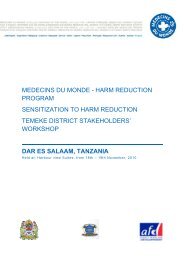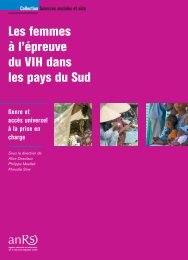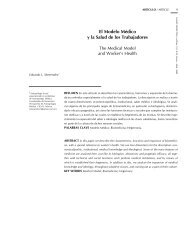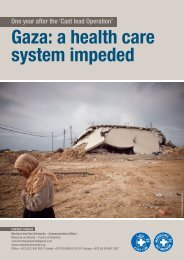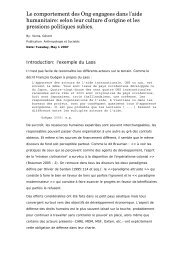Blame & Banishment - Médecins du Monde
Blame & Banishment - Médecins du Monde
Blame & Banishment - Médecins du Monde
Create successful ePaper yourself
Turn your PDF publications into a flip-book with our unique Google optimized e-Paper software.
<strong>Blame</strong> and <strong>Banishment</strong>: The underground HIV epidemic affecting children in Eastern Europe and Central Asia<br />
SECTION III Children of the streets:<br />
The end of childhood…<br />
“Yana was just eight years old when she started living on the streets. Her father, an<br />
alcoholic, died young and she was separated from her mother who was sent to jail. Originally<br />
from Moldova, one of the poorest countries in Europe, Yana wandered through several towns<br />
and eventually ended up on the streets of Odessa, Ukraine. Her ‘home’ was a makeshift shed in<br />
a park. A group of 20 street children built the hideout themselves, the youngest only six years<br />
old. They begged, stole and prostituted themselves to survive. Drugs helped them cope with their<br />
lives. Through sharing needles they also shared HIV. Yana fell sick and died at the age of 13 on<br />
”<br />
the streets of Odessa, addicted to drugs and infected with HIV…<br />
Today, street children in the region are dying of AIDS and drug use in much the same way<br />
as they died of cold, famine and typhoid in the twentieth century. A recent study of 15- to<br />
19-year-old street children in St Petersburg, involving 313 participants, found that almost<br />
40 per cent of them were HIV-positive. Injecting drug use was found to be the strongest<br />
risk factor, with a greater than twentyfold increased risk of HIV. More than half of them (51<br />
per cent) had experience of injecting drug use; 96 per cent were sexually active; and 24 per<br />
cent had more than six sex partners per year. 33 High levels of HIV prevalence have also been<br />
found among street children in studies in Odessa and Donetsk, Ukraine. 34<br />
The phenomenon of street children is not new and has deep historical roots in the region.<br />
During the last century, millions of children were pushed onto the streets <strong>du</strong>ring periods of<br />
war, civil unrest and famine. However, as these children were not supposed to exist in a<br />
‘developed socialist society’, there were no official statistics about them. The problem was<br />
kept ‘under control’ through a network of state-run institutions for orphans and neglected<br />
children. Institutionalization was believed to be the best approach to ensuring the wellbeing<br />
of children otherwise doomed and exposed to the dangers of living on the street. The<br />
approach included a police-run department in charge of collection and placement of children<br />
who ran away from homes or orphanages, and a network of closed boarding institutions<br />
where children aged 5–17 were placed. There was little accountability or questioning of any<br />
abuses taking place in such institutions.<br />
31



